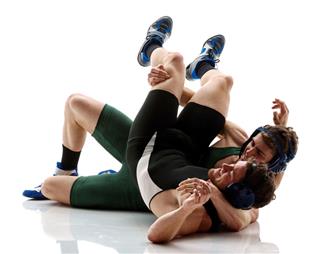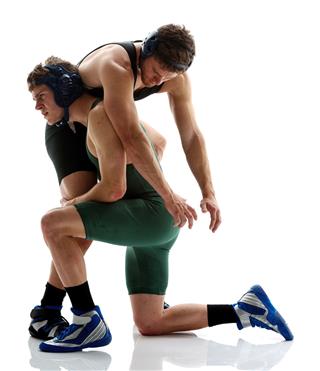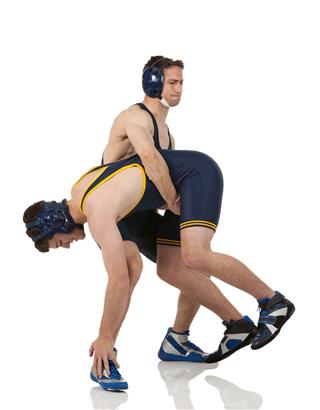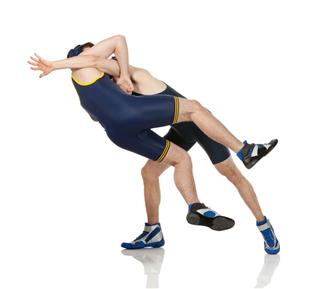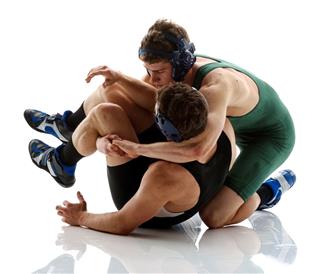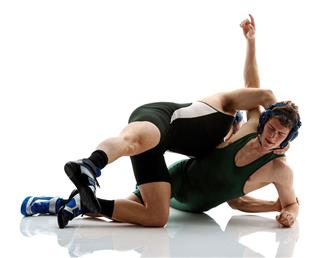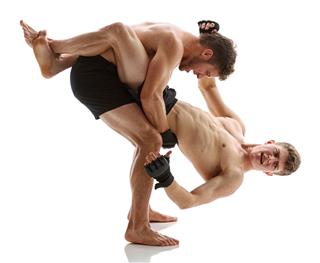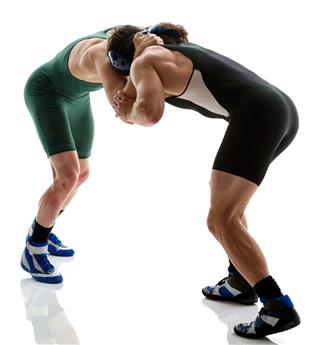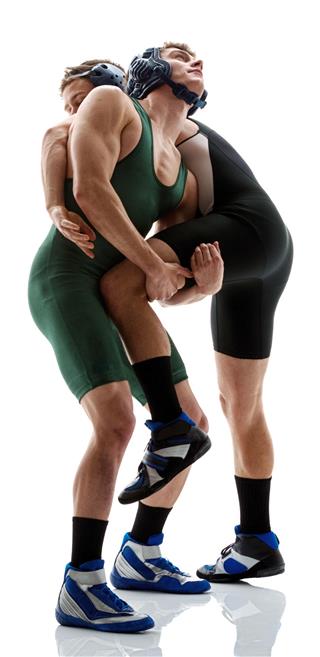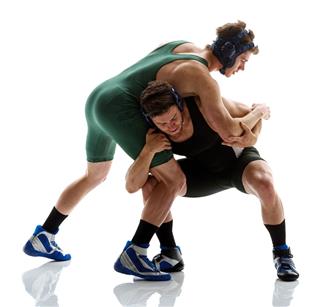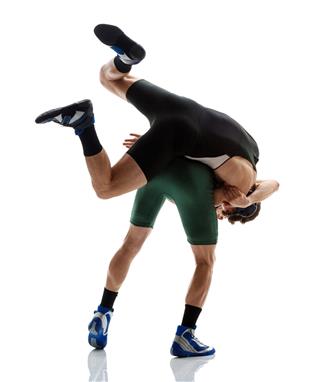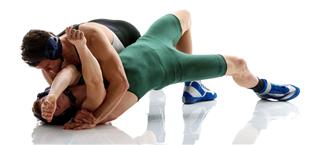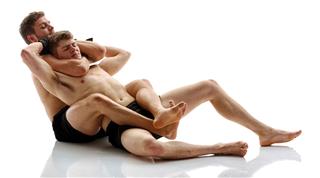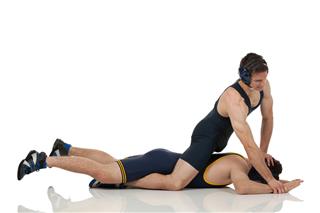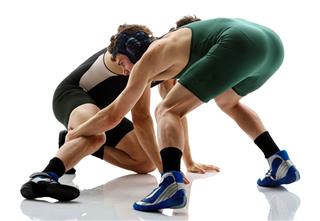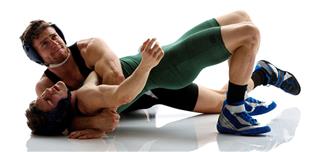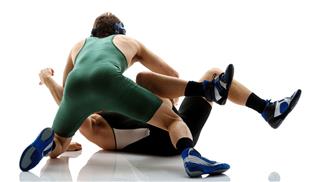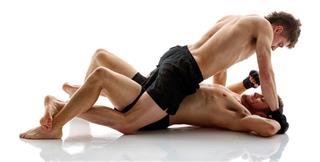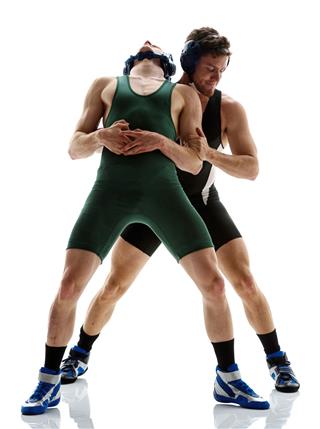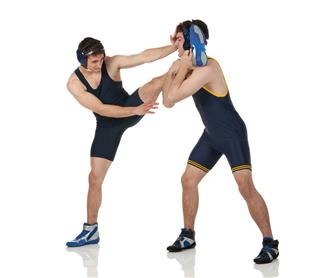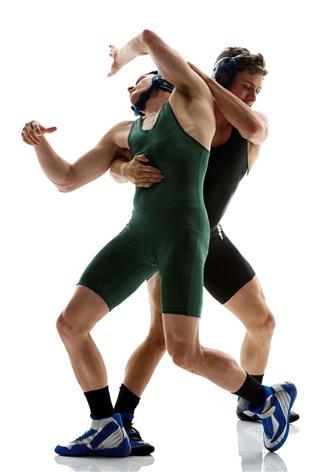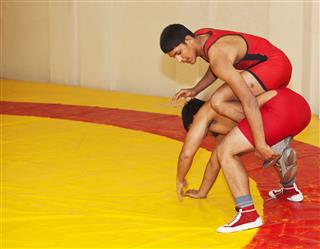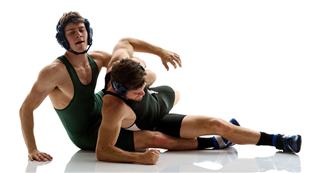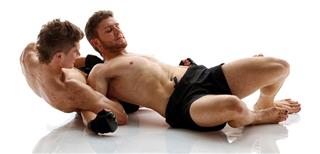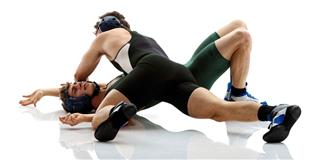
Wrestlers use a combination of attacks, holds, and throws while competing in a wrestling match. In this article, we will take a look at some of the most popular wrestling moves.
Wrestling is one of the oldest combat sports of the world. It is believed that it was a major sport in the ancient Greek and Roman empires. The sport flourished in the Middle Ages and remained popular with the masses as well as the monarchies. Over the years, wrestling has become one of the major sports of the world. Some of the most popular styles of wrestling today are freestyle wrestling, Greco-Roman, and professional wrestling. Professional wrestling, also known as pro wrestling, is the most popular of them all, and is extensively aired on television. Although professional wrestling has incorporated most of the moves that are used in freestyle wrestling, certain finishing moves and attacks can only be performed in a pro wrestling match. Also, unlike Greco-Roman and freestyle wrestling, the moves in pro wrestling are choreographed and the wrestlers have to ‘act’ according to the script. However, it does not mean that the moves performed in pro wrestling are fake. Pro wrestlers are required to be fit and athletic so that they can pull off those stunning moves. Let us now take a look at some of the popular wrestling moves.
Aerial Moves
Single Leg Takedown
In this move, the wrestler grabs either of the legs of his opponent with his hands in order to throw him off balance onto the ground. Wrestlers either grab the lower portion of their opponent’s leg, or the crotch area to push their opponent to the ground. The other style of executing this move is to grab both of the opponent’s legs, while keeping your chest close to him, and then tripping him on the ground.
Tie Up

A wrestler is said to have tied up his opponent if he holds a part of the opponent’s body in such a way that the opponent finds it difficult to extract himself. The body parts that are usually targeted are the arms, and the head.
Duck Under

In this move, the wrestler ducks under either of the arms of his opponent to gain control of his body.
Arm Twist Ropewalk Chop

In this move, the wrestler grabs his opponent’s arm, and twists it to gain control over his body. The wrestler then climbs on the top rope using the turnbuckles and jumps on the chest, or back of the opponent.
Diving Elbow Drop

The wrestler jumps from the top rope with his elbow cocked and lands it on the chest, or neck of his opponent. A variation of this move is the diving back elbow drop, in which the wrestler stands face-away from his supine opponent and dives backward to hit him with his cocked elbow.
Diving Bulldog
In this move, a wrestler grabs his opponent’s head and jumps forward to force the opponent’s face in the mat. There are numerous variations of this move including cobra clutch bulldog, inverted bulldog, slingshot bulldog, etc. These moves are collectively known as facebusters.
Diving Crossbody
In this move, the wrestler climbs on the top rope and jumps on his opponent’s torso with an intention to pin him.
Diving Double Axe Handle

In this move, the wrestler stands on the top turnbuckle and jumps on his opponent while joining his hands together in the shape of a holding an ax. To perform this move, the opponent needs to be in a rising or a standing position.
Diving Knee Drop

In this move, the wrestler jumps from the turnbuckle onto his opponent, landing his knee on the torso of his opponent.
Diving Leg Drop

This move is similar to the diving knee drop with the only difference being that instead of the knees, the wrestler uses the lower part of his legs to hit the opponent.
Diving Shoulder Block
In this move, the wrestler jumps from the turnbuckle and hits his opponent with his shoulders.
Diving Double Stomp

The wrestler jumps from a raised position onto the body of his opponent, and drops his foot on the torso or arm of the opponent.
Flying Calf Kick
As the name suggests, the wrestler jumps from the turnbuckle to kick his opponent with the back of his leg. This move works only when the opponent is in raising or standing position.
Flying Clothesline

In this move, the wrestler jumps from the turnbuckle with his arm extended and hits his opponent on the chest or the neck to knock him down.
Flying Neckbreaker

The wrestler jumps from the turnbuckle onto his opponent and grabs his neck in midair to knock him down.
Flying Spinning Heel Kick

In this move, the wrestler jumps from the turnbuckle and spins about 360 degrees in the air to hit his opponent with the back of the leg.
Moonsault

In this move, the wrestler does a backflip from the turnbuckle and lands onto his opponent to knock him down.
Splash

A splash is a move in which a wrestler lands stomach first on to his opponent who is lying on the ground. To perform this move, the wrestler jumps from an elevated position such as a turnbuckle.
Shooting Star

The wrestler jumps from the turnbuckle and does a backflip, while pressing his knees against his chest, and lands stomach-first on his opponent who is lying on the ground.
Sunset Flip
The wrestler jumps from the top turnbuckle over the opponent (the opponent has to face the wrestler executing the move) and executes a waist-lock on him. The wrestler then rolls on the ground, pulling his opponent backwards to create a pinning position.
Plancha

Plancha is one of the most popular moves of professional wrestling. In this move, the wrestler jumps outside the ring in such a way that his chest hits the body of the opponent. This move is usually executed in two ways. Either the wrestler will come running after gaining momentum from the ropes and jump over the top ring onto the opponent, or he can climb up to the top turnbuckle and land on his opponent.
Topé
Tope is similar to plancha, with the only difference being that instead of the wrestler going over the ropes, he goes through them to attack the opponent with the head.
Attacking Moves
Body Avalanche
The wrestler hits the opponent in such a way that his back strikes against the turnbuckle. This move is usually used by bulky wrestlers.
Backhand Chop

The wrestler slaps the opponent’s chest using his backhand. The move is known more for the humiliation it causes to the opponent rather than the actual damage.
Clothesline

In this move, the wrestler charges towards his opponent (who needs to be standing) and extends his arms to hit him either at the neck or chest, in order to knock him down.
Butt Drop

In a butt drop, the wrestler lands on the chest of his opponent, by using his butts. This move is used by many wrestlers to pin the opponent.
Elbow Drop

In an elbow drop, the wrestler falls onto his opponent in such a way that his elbow comes in contact with the opponent’s chest or shoulders.
Back Elbow
This is a counter-attack move used by wrestlers against a charging opponent. The wrestler strikes the opponent with the back of his elbow. It is sometimes used as a surprise move.
Facewash
To execute this move, the opponent needs to be at the bottom corner turnbuckle. The wrestler rubs his sole against the face of the opponent, and after gaining momentum by running to the opposite ropes (rebounding), strikes him with a kick.
Forearm Club

In this move, the wrestler and the opponent are positioned in such a way that the attacking wrestler’s chest is facing the back of his opponent. The attacking wrestler grabs the opponent’s head with one hand and uses the other hands to strike a fist onto his chest.
Headbutt

In this move, the wrestler charges at the opponent and leaps at him in such a way that the opponent’s forehead is targeted by the attacking wrestler’s head.
High Knee
In this move, the wrestler runs towards the opponent and strikes his knee against the opponent’s head or face.
Back Kick

In this move, initially, the wrestler is facing his opponent. The wrestler then turns 180°C and hits the opponent on the face or the chest, with the sole of his boot.
Big Boot

In this move, the wrestler uses the momentum of his opponent to counter-attack him. When the opponent comes charging at the wrestler (who is in standing position), the wrestler sticks out his leg at an inclined angle to reach the head of the opponent.
Enzuigiri

This move is usually performed by wrestlers who have some sort of martial arts background. This move is often used when the first kick of the attacking wrestler has been blocked and held by the opponent. To extract himself from this situation, and to counter-attack the opponent, the attacking wrestler jumps to kick the back of the opponent’s head.
Lariat Tumblr

In this move, the wrestler runs towards his opponent and hits him with his upper chest, with the intention of knocking him to the ground.
Leapfrog Body Guillotine
To execute this move, the opponent should be resting against the ropes in a standing position, facing out of the ring. The attacking wrestler comes charging at the opponent from behind and jumps on the opponent’s back and neck, sliding through the ropes to reach out of the ring, knocking the opponent down.
Holds
Chinlock

In this move, the wrestler holds the chin of the opponent (who is in a sitting position) while placing his knee against the opponent’s back. The wrestler then pulls the opponent’s chin to inflict pain on him.
Camel Clutch

In this move, the wrestler sits on the back of his opponent and applies a chinlock on him. The attacking wrestler then pulls the opponent’s head and torso backwards causing immense pain, in order to gain a submission from him.
Clawhold

Clawhold is a move in which an attacking wrestler squeezes the skull of the opponent using the last two knuckles of his hand.
Crossface

In this move, the wrestler locks the opponent’s arm in his leg and then wraps his neck in the arms, pulling the opponent’s head backwards.
Mandible Claw

In this move, the attacking wrestler inserts his middle and ring fingers into lower part of the opponent’s mouth. The attacking wrestler uses the rest of his fingers to hold the opponent’s jaw.
Head Scissors

In this move, the wrestler uses his legs to wrap them around the opponent (both the wrestler and the opponent are in prone position) to choke him into submission.
Nelson Hold

Usually, this move is executed when both the wrestler and his opponent are in standing position. The opponent has his back towards the attacking wrestler, who uses his arms to lock the arms of the opponent. The attacking wrestler’s arms then encircle the neck of the opponent to inflict pain.
Stepover Toehold Facelock

In this move, the wrestler lies on top of the opponent who is lying face down. The attacking wrestler locks the opponent’s ankle in his legs and wraps his arms around the opponent’s neck and chin. The wrestler then pulls the opponent’s neck to gain submission.
Armbar

The wrestler takes hold of the opponent’s arm and twists/exerts pressure on it to target the arm and the shoulders.
Chicken Wing

In this move, the attacking wrestler grabs the opponent’s arm and pulls it around his back to induce pain in the shoulders.
Bear Hug

The attacking wrestler wraps his arms around the opponent and squeezes him to inflict pain around his ribs.
Waist Lock
This move is similar to bear hug, the only difference being that in bear hug, the attacking wrestler is facing the opponent, whereas in this move, the attacking wrestler faces the back of the opponent. The areas targeted are the ribs and spine.
Boston Crab

In this move, the attacking wrestler is standing and the opponent is in supine position. The wrestler hooks each of the opponent’s legs in his arms and then turns the opponent in such a way that the final position has the wrestler in a semi-sitting position on the back of the opponent, who is lying face-down on the ground.
Ankle Lock

In this move, the wrestler grabs the opponent’s foot and wraps his arms around the toe and the ankle of the opponent to put pressure on them.
Anaconda

This move involves the wrestler wrapping his arms around the head and one arm of the opponent to squeeze him.
Corner Foot Choke

To execute this move, the opponent should be at the corner turnbuckle with his back resting against the ropes. The wrestler pushes his leg onto the throat of the opponent in an attempt to choke him. The move is considered illegal after the count of five.
Double Choke
The wrestler grabs the throat of the opponent with both his hands in order to throttle him.
Finishing Moves
In professional wrestling, most wrestlers execute a finishing move, which leads to a pinfall. These moves often signify that the attacking wrestler is going for the pinfall and the opponent may now lose the match. Some of the greatest wrestlers around the world have their own signature finishing moves. Below is a list of some of the most popular finishing moves in wrestling.
Undertaker: Tombstone Piledriver
One of the most stunning moves in professional wrestling, this move is performed by The Undertaker. In this move, The Undertaker lifts his opponent on one shoulder and positions him in such a way that the opponent’s legs are vertically upside and the head is near his thighs. The arms of the opponent are wrapped around Undertaker’s waist. The Undertaker then bends his knees to the ground, while keeping his opponent in the same locked position, hitting the opponent’s head to the ground. As the opponent lies supine on the ground, The Undertaker makes the pin by folding the opponent’s arms onto his chest, pressing the arms so that the shoulders are in contact with the ground.
Hulk Hogan: Leg Drop
Hulk Hogan was one of the most popular wrestlers of his era and his finishing move was very popular among wrestling fans. In this move, known as the ‘The Leg Drop’, or ‘The Big Leg’, Hogan first made the opponent supine by landing a few kicks and blows on him. He would then run across the ropes and jump onto the opponent’s throat with his leg, leading to a pinfall.
Hit Man: Sharp Shooter
Bret “Hit Man” Hart’s finishing move was elegant and simple. He would twist both the legs of the opponent and hook them against his own. He would then flip the opponent into a prone position and lean back to compress his lower back. Hit Man didn’t use this move for pinfall, but for gaining submission from the opponent.
Triple H: Pedigree
Triple H’s Pedigree is one of the most stunning moves in professional wrestling and gets the crowd into the game. Triple H grabs the head of the hunched opponent between his legs and locks the opponent’s hands behind his back. He then jumps and lands onto his knees hitting the opponent’s head to the ground with full force.
Big Show’s Choke Slam
Big Show grabs the opponent’s throat with his hand and lifts him up in the air. He then throws the opponent down with full ferocity and proceeds to do the pinfall.
John Cena: Attitude Adjustment
John Cena lifts the opponent using his shoulders and upper back. Cena then throws the opponent onto the ground in a sideways position and proceeds to do a pinfall.
Rey Mysterio: The 619
This finishing move is named after the local area code in Mysterio’s hometown. In this move, the opponent is set against the ropes and is facing out of the ring. Rey Mysterio comes running in after gaining momentum off the opposite ropes and slides through the second and the third rope to kick the opponent in the face. He follows it up by climbing onto of the rope and jumping chest-first onto his opponent.
Brock Lesnar: The F5/The Verdict
Brock Lesnar was known for his brute power and his finishing move was a proof of that. In this move, Brock Lesnar lifts the opponent onto his shoulders using his right arm. With the opponent firmly gripped on his shoulders, Lesnar grabs the opponent’s farthest leg and slams him, landing him face-first on the ground.
Stone Cold: Stunner
Stone Cold’s finishing move is indeed a stunner of some sorts. Stone Cold sets up this move by bringing the opponent in a hunched position. He then grabs the head of the opponent in such a way that it is locked between his biceps and his shoulder. Once he knows that the prey is firmly gripped, he turns away and jumps hitting the opponent on his face. All this happens in a matter of a few seconds and then Stone Cold goes for the pin.
Goldberg: The Jackhammer
Goldberg was a wrestler that the audience loved to watch. His finishing move, the Jackhammer was one of the most lethal moves in pro wrestling. In this move, Goldberg grips the opponent and lifts him up in such a way that the opponent’s legs are vertically upwards. Goldberg then drops the wrestler onto the ground, without losing the grip on the opponent and goes for the pin.
The Rock: The People’s Elbow
The Rock is one of those pro wrestlers who have made a name for themselves in Hollywood. His finishing move, ‘The People’s Elbow’ is considered one of the weakest finishing moves in pro wrestling history, but it was The Rock’s sheer charisma that the crowd erupted every time he started sniffing and removing his elbow pad – a symbolic gesture that signified that The People’s Elbow was to follow. The move is pretty straightforward. The Rock criss-crosses the ring, gaining momentum from the ropes, and finally stops by the supine opponent to deliver a lethal elbow onto the opponent’s ribs. The move usually leads to a pinfall.
